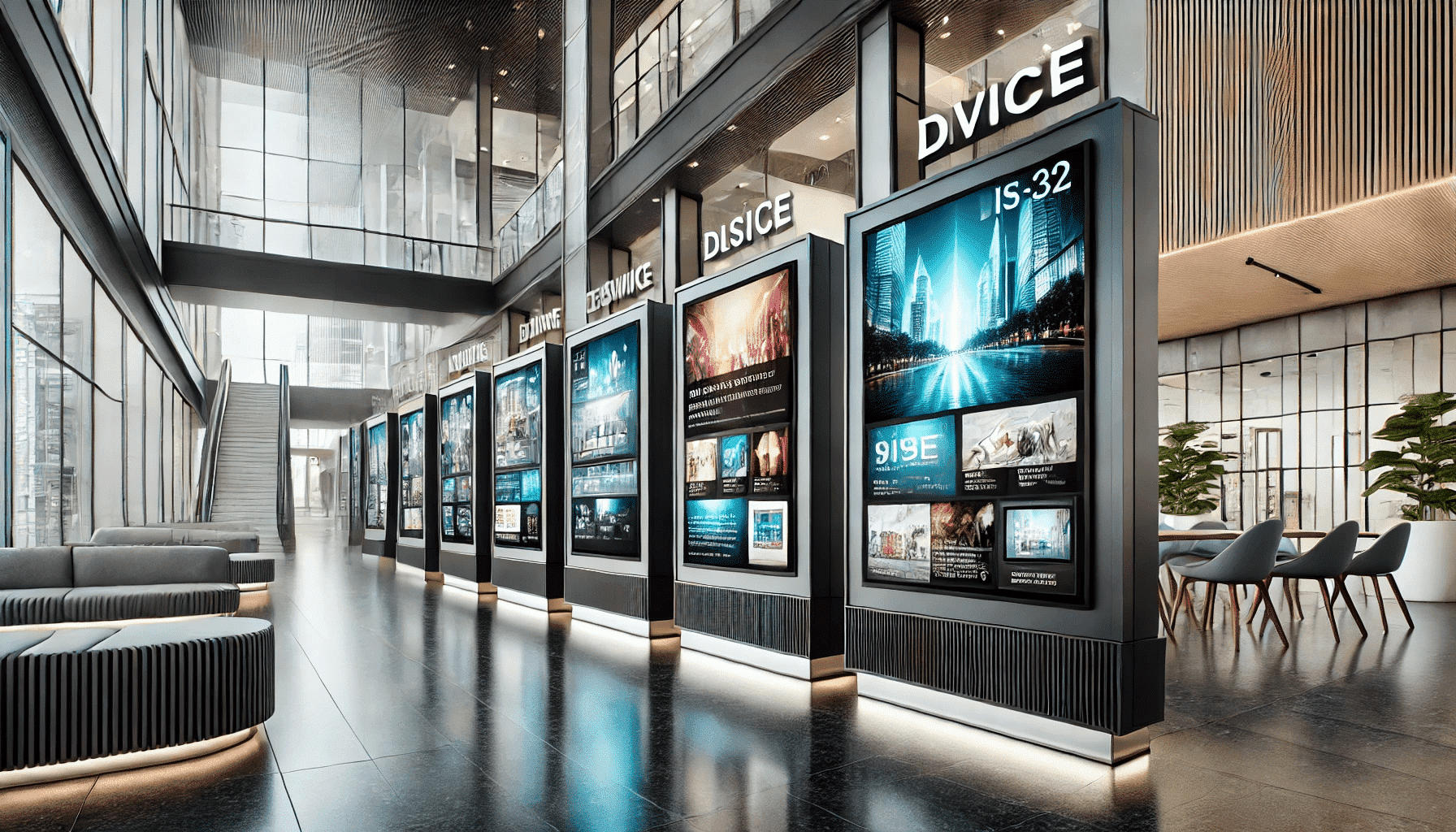
Ready to install digital signage? This guide will cover everything from planning to digital signage installation to make your setup seamless and effective.
Key Takeaways
• Digital signage systems, valued at $24.86 billion, enhance audience engagement and provide real-time updates, making them a superior choice over traditional advertising methods.
• A successful digital signage installation requires careful planning, including site assessments and strategic content management, to ensure optimal performance and audience interaction.
• Hiring certified professionals for digital signage installation can streamline the process, leveraging industry expertise to achieve effective and efficient implementations.
Understanding Digital Signage Systems
Digital signage systems serve as a robust communication channel that uses digital displays to share information, advertisements, or entertainment. These systems are part of a rapidly growing market, valued at approximately $24.86 billion, with an anticipated annual growth rate of 8% through 2030.
Digital signage allows businesses to elevate their social media advertising strategy, reaching audiences more effectively and dynamically than traditional methods.
Components of Digital Signage Systems
A digital signage network is comprised of several key components that work together to deliver content seamlessly. At the heart of any digital signage system are the displays, which can range from simple screens to sophisticated video walls. Media players store and send content to these displays, while the content management system (CMS) allows for scheduling, changing displays, and remote monitoring.
Among the types of displays, LED and LCD panels are the most common. LED displays are known for their high brightness and energy efficiency, making them ideal for outdoor use, whereas LCD displays are favored for their vibrant colors in indoor settings.
The CMS is crucial for managing content across the network, enabling real-time updates and remote control. Together, these components form the backbone of effective digital advertising solutions.
Benefits of Digital Signage
The dynamic nature of digital signage captures viewer attention far more effectively than static displays. This capability allows businesses to engage their audience in real-time, making immediate updates and adjustments based on current market trends. Whether it’s displaying the latest promotions or urgent information, digital signage systems ensure your message is timely and relevant.
Not only does digital signage offer enhanced engagement, but it also leads to significant cost savings. By reducing the need for printed materials and manual updates, businesses can allocate resources more efficiently.
Overall, digital signage represents a modern advertising solution that provides a multitude of advantages over traditional methods, transforming the way businesses approach digital campaigns and marketing.
Planning Your Digital Signage Installation
Effective digital signage installation requires meticulous planning to ensure optimal performance and audience engagement. Key considerations include:
• The placement of displays
• Visibility
• Traffic flow
• Access to power and network connections
Conducting a thorough site assessment and establishing a robust content strategy helps businesses overcome common installation challenges and maximize the impact of their digital signage network.
Site Assessment
A comprehensive site assessment is crucial for the successful implementation of digital signage. Factors such as visibility to the intended audience, accessibility for optimal traffic flow, and proximity to power and network connections must be meticulously evaluated. Identifying and addressing potential obstacles during the site assessment phase ensures that the digital signage placement is effective and unobstructed, leading to better audience engagement.
Content Strategy
A well-defined content strategy is the backbone of any effective digital signage campaign. By understanding the specific needs of the audience and the strategic placement of screens, businesses can tailor their messages for maximum impact. Digital signage has been shown to improve retail outcomes by up to 40%, enhancing both engagement and sales. This level of improvement underscores the importance of a strategic approach to content creation.
Digital signage installations have consistently proven effective in enhancing customer engagement and brand recognition across various industries. Delivering targeted, dynamic content significantly boosts a business’s presence and drives sales. Whether it’s through real-time promotions, interactive displays, or engaging advertisements, a solid content strategy is indispensable for achieving business goals.
Essential Tools for Digital Signage Installation
Installing digital signage systems requires a set of essential tools to ensure a stable and secure setup. These tools include mounting hardware, power tools, and cable management supplies. Having the right tools not only simplifies the installation process but also ensures the longevity and reliability of the setup.
For installations in high or overhead locations, a sturdy and safe ladder is also necessary.
Mounting Hardware
Mounting hardware is a critical component of any digital signage installation. The type of hardware required varies based on the size and type of the display. Choosing the right hardware is essential for ensuring that the display is securely held in place, minimizing the risk of damage or displacement during installation.
Power Tools and Accessories
Power tools and accessories are indispensable for a smooth installation process. A stud finder is crucial for locating wooden studs when mounting the display, and a level ensures that the display is mounted straight and perfectly horizontal. These tools help achieve a professional and secure installation.
Cable Management Supplies
Proper cable management is vital for both the functionality and aesthetics of digital signage installations. Common supplies include cable ties, clips, trunking, and conduits, which help maintain a tidy appearance and enhance safety. Effective cable management not only improves the visual appeal but also ensures that the system operates smoothly without the risk of tangled or damaged cables.
Step-by-Step Digital Signage Installation Process
Installing digital signage involves a meticulous process that includes planning, connecting components, and ensuring secure mounting. The appropriate tools simplify the installation and stabilize the setup. Essential tools include flat-head and Phillips-head screwdrivers, power drills, and drill bits for a smooth installation.
Preparing the Installation Site
Preparing the installation site involves marking positions to ensure displays are aligned according to design specifications. Accurate marking can be achieved using tools like a laser level or chalk line. It is also crucial to ensure that the mounting surface can support the weight of the display, which may require reinforcement.
Following these steps will help prepare the site efficiently, leading to a successful digital signage setup.
Installing the Display
During the installation of digital signage displays, safety is paramount. Wearing safety goggles, gloves, and protective footwear ensures that the installation process is conducted safely. The digital signage display can be connected to a standalone device, PC, or a cloud-based system to function properly. Ensuring the display is connected to both the power source and the signage player is essential for its operation.
Proper mounting of the display involves marking screw or bolt points aligned with the mounting holes. After marking the points, drill holes and secure the mount to ensure stability. Always refer to the manufacturer’s instructions when attaching the display to the mount, and ensure the display is securely attached before letting go.
Using a stud finder is crucial for accurately locating secure wall studs during the mounting process.
Configuring the System
Configuring the digital signage system involves setting up the software, including playlists, schedules, display zones, and network settings. This step is crucial for managing the content and ensuring that the digital signage operates smoothly and effectively.
Testing and Troubleshooting
After installation, running a complete system check is essential to identify any issues such as signal loss or connectivity problems. Regularly monitoring performance metrics can help pinpoint areas that need improvement, ensuring the digital signage system continues to deliver optimal results.
Choosing the Right Display Technology
Choosing the right display technology is crucial for maximizing the effectiveness of digital signage. Businesses can choose from various types of displays, including LED video walls, LCD displays, and all-in-one LED displays, each catering to different business needs. Important specifications to consider include resolution, brightness, contrast, and aspect ratio, which can significantly influence the visual output.
LED vs. LCD Displays
Different types of display screens are available for digital signage, including LED, LCD, and OLED, each offering unique benefits and visual qualities. LCD displays are particularly known for their vibrant colors and cost-effectiveness, making them an excellent choice for indoor environments where controlled lighting conditions prevail.
On the other hand, LED displays are celebrated for their high brightness and energy efficiency, which makes them suitable for outdoor advertising where visibility in various light conditions is essential. Understanding the appropriate applications for different displays helps businesses select the best technology for their needs.
LCD displays are ideal for indoor settings where image quality is paramount, while LED displays excel in outdoor scenarios requiring high visibility and energy savings. Choosing the right technology ensures that digital signage systems deliver maximum impact and efficiency.
Interactive Displays
Interactive displays bring a new level of engagement to digital signage, enabling users to interact directly with the content through touch-based systems. These displays support multiple touch points, allowing for a more immersive and customized user experience.
In industries ranging from retail to education, interactive displays can enhance customer engagement, provide valuable analytics, and deliver a tailored experience that traditional displays cannot match.
Perfecting Your Digital Signage Strategy
Perfecting a digital signage strategy involves ongoing management and content optimization to align with audience preferences and business goals. Breaking down the installation process into manageable steps and continuously optimizing content maximizes the return on investment from digital signage systems.
Leveraging programmatic advertising and strategic thinking provided by industry solutions like Mvix can significantly enhance the effectiveness of digital campaigns.
Content Creation Tips
Creating engaging content is essential for attracting customer attention and enhancing their experience. Successful brands like Adidas and McDonald’s have utilized digital signage in innovative ways to improve customer engagement and increase sales. For instance, Adidas used digital signage in pop-up stores to enhance the customer experience and drive foot traffic during promotions, while McDonald’s implemented digital kiosks to improve order accuracy and reduce wait times.
Footwear retailer SoleTrader reported increased brand visibility and customer engagement after implementing an in-store digital signage system. Similarly, Shelter Mutual Insurance expanded its use of digital signage from simple menu displays to comprehensive engagement tools, resulting in increased employee interaction and satisfaction.
A/B testing can also help identify the most effective types of content for a target audience, ensuring that the digital signage strategy remains relevant and impactful.
Regular Maintenance
Regular updates and maintenance are necessary to ensure digital signage systems operate smoothly and continue to deliver optimal results. Consistent management and monitoring of the system allow businesses to address issues promptly, maximize revenue, and support long-term success.
Expert Services for Digital Signage Installation
Hiring professional services for digital signage installation can simplify the entire process, covering everything from planning to execution. Certified technicians bring expertise and efficiency to the table, ensuring seamless deployments and on-site quality support.
Choosing a service provider with extensive experience in digital signage installations guarantees better project outcomes tailored to specific needs.
Benefits of Hiring Professionals
The benefits of hiring professionals for digital signage installation are manifold. Certified technicians, with an average of 15 years of experience, ensure high-quality service and a smooth system launch by collaborating closely with the client’s IT team. The Mvix professional services team, for instance, works alongside the IT and communications team to align digital signage strategies with business goals. Certified technicians are available across all 50 states, providing comprehensive support.
Professionals also bring industry expertise, reinforced by years of experience, ensuring a professional installation process that leads to greater efficiency and effectiveness. Leveraging the skills of an experienced team helps businesses achieve their digital signage objectives more effectively and with less hassle.
Finding the Right Service Provider
Choosing the right service provider for digital signage installation is critical to the success of the project. Look for providers who hold relevant certifications and credentials, demonstrating a commitment to quality and adherence to industry standards. Evaluating a provider’s reputation through customer reviews and testimonials can provide valuable insights into their reliability and service quality.
Ensuring cost transparency can help avoid hidden fees and miscommunication regarding project budgets.
Case Studies: Successful Digital Signage Installations
Real-world examples of successful digital signage installations provide valuable insights into the practical applications and benefits of digital signage in various business environments. These case studies demonstrate how digital signage can transform customer experiences and improve internal operations, showcasing its versatility in diverse settings.
Retail Store Transformation
In retail settings, digital signage has significantly enhanced sales and customer engagement. For instance, Merrimack Valley Psychological Associates doubled their revenue within six months after partnering with WebFX.
Effective digital signage leads to improved customer interactions through dynamic content, real-time promotions, and interactive displays, ultimately driving increased sales and engagement with customer data.
Corporate Communication Enhancement
Digital signage has also proven to be a powerful tool in corporate environments, improving internal communication and employee engagement. Companies like Sephora and Tesla have leveraged digital signage to enhance the customer experience and boost cross-channel sales.
Displaying real-time updates and vital information makes digital signage a powerful tool for enhancing internal communication and productivity, creating a more engaging environment for employees and customers alike.
Summary
In summary, digital signage solutions offer transformative benefits for businesses, from enhancing customer engagement to streamlining communications. By understanding the components and benefits of digital signage systems, planning installations meticulously, choosing the right display technology, and maintaining a strategic approach to content creation and maintenance, businesses can maximize the impact of their digital campaigns. Leveraging professional installation services further ensures a seamless and effective deployment. Embrace the power of digital signage to elevate your advertising strategy and achieve remarkable results.




